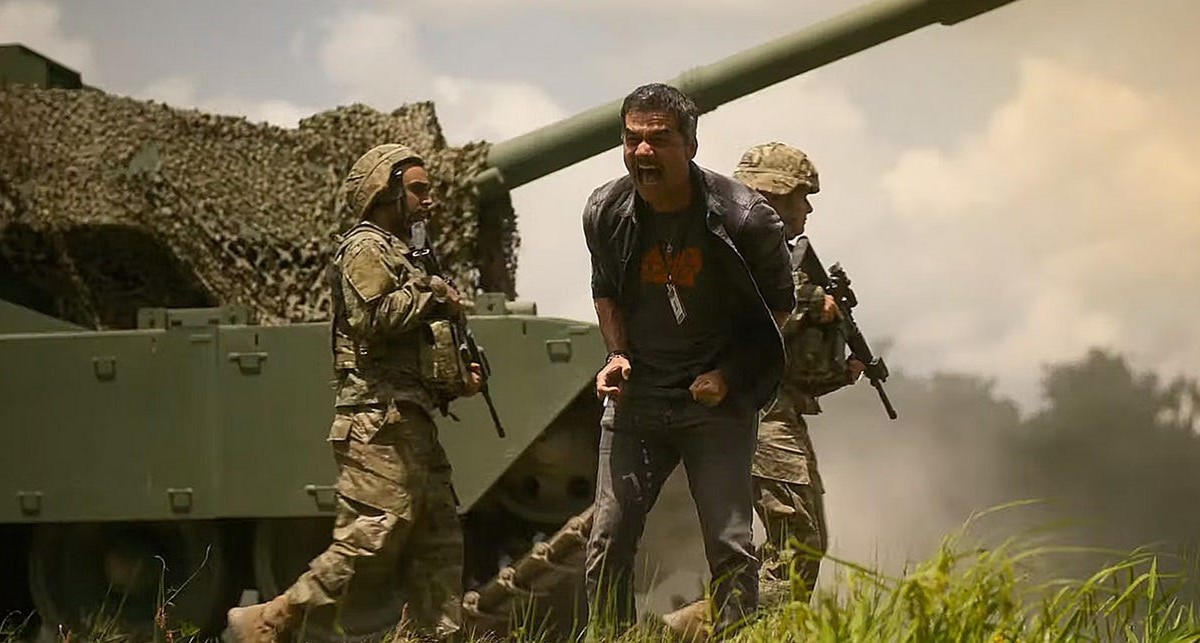by Terrence Rafferty
The Marine Corps training camp where the first, and more striking, half of Full Metal Jacket takes place looks more like a medical facility than a military one. The barracks are lit as brightly and evenly as an operating theater, the walls are a uniform white and every surface has been scrubbed to an antiseptic shine. Welcome to Stanley Kubrick’s place. The director greets us with a montage of recruits having their heads mowed with electric clippers and, as it turns out, this scene signifies more than just the loss of the young soldiers’ individuality. As the movie whirs along, drilling its ideas into our skulls with relentless concentration, we realize that, in a sense, the Marines’ heads have been shaved for surgery: basic training is an operation on their brains, a procedure that excises, with laserlike precision, all traces of humane and civilized impulses and implants in their place the hard instincts of killers. We’ve watched this process before, in countless war movies, but the punishing rigor of Kubrick’s treatment is new: he works on the audience as single-mindedly as the drill instructor, Sergeant Hartman (Lee Ermey), works on his recruits. Kubrick leaves us rubbing our heads and wondering where the feeling went.
Kubrick’s approach is bold, in a rather outdated way. The recruits chant Marine doggerel in unison, Hartman screams obscenities like incantations, men in white skivvies arrange themselves in symmetrical group compositions–it’s all spectacle, ritualized performance, like an avant-garde theater production of the 1960s. (The nearest film equivalent is probably Jonas Mekas’s The Brig, made in 1964.) Pressed to defend this technique, Kubrick would probably say that there’s no way for us to understand something as unnatural as training for war unless we allow him to manipulate and depersonalize us in the same manner: if we put ourselves in his skilled hands, surrender our will and our intelligence, he’ll abuse us for our own good. Tell it to the Marines, Stanley. These assaultive methods might work–just–if this spectacle were truly autonomous, if the movie ended with the end of basic training. But the story (adapted by Kubrick, Michael Herr and Gustav Hasford from Hasford’s novel The Short-Timers) goes on, following a character known as Private Joker (Matthew Modine) to Vietnam around the time of the Tet offensive, and at that point Kubrick’s radical surgery on the dramatic conventions doesn’t look like such a good idea; he’s cut away too much. The characters remain dehumanized, the audience remains desensitized and Vietnam has never seemed farther away.
Full Metal Jacket certainly isn’t what we expect a Vietnam movie to be. Then again, it’s only secondarily a movie about the war. First and foremost, this is a Kubrick movie: self-absorbed, self-referential, formally overdetermined, distanced without being the least bit rational or objective. The big question, as always, is not what Kubrick’s doing but why he’s doing it. Dissertations could–no, will–be written on the formidable and peculiar technique of this picture: no amount of stylistic analysis, however, is likely to explain why a man would devote more than three years of his life to making a war movie in which violent death isn’t meant to move us. Does Kubrick really think we’re not callous enough about war, that we’d see it more clearly under anesthesia? By plunging us straight into the living theater of basic training, and then, after an abrupt midpicture break, straight into the war itself–each time without bothering to fill in the tiniest details of his characters’ personal histories–Kubrick reduces everything and everyone to the merely functional. “You will be a weapon,” Hartman announces to his recruits at the beginning of the film, and we can’t even feel horror or sadness at the way these young men are objectified, because Kubrick never gives us any indication that they had any humanity to lose. When soldiers introduced in the second half of the film are picked off by a sniper in Huè, there’s nothing to respond to but the aesthetic effect of action-painting sprays of blood and the sculptural contortions of dying bodies: the life these men have been given on screen is so pale we barely feel its loss. We’d be more startled if one of the small, evenly burning orange fires, impeccably placed among the ruins in every composition, were to go out or begin to blaze uncontrollably: that, in this movie’s scheme, would be an event. But they, like the characters, just flicker quietly in the background, unchanging and indistinguishable from each other, taking up their assigned spaces in the artful tableaux.
Kubrick’s “Vietnam movie” is a pure abstraction that doesn’t illustrate the brutality of war so much as echo it. The long boot-camp sequence is, in many ways, the most forceful work he’s done in years–he’s frighteningly into it. (These scenes, which take up barely a sixth of Hasford’s novel, account for nearly half of Kubrick’s movie.) He actually seems to share the drill instructor’s relish in deconstructing and reconstructing his charges’ personalities. Hartman, with his exhausting endurance courses and his ceaseless barrage of psychological abuse, reduces his young men to the barest human essentials, emotional and physical: he makes them raw material again, so he can create them fresh, in the Marines’ image. He even gives them new names upon meeting them for the first time–Joker, Cowboy, Gomer Pyle–and the recruits never use their old names again, even among themselves. In part, these passages read as a blasphemous parody of the creation (Hartman, speaking chummily of God, says, “He plays his games, we play ours”) and a clinical dissection of the process by which men are “born again.” The sergeant’s most abject, then most dangerously zealous, pupil is the one called Pyle (Vincent D’Onofrio), a fat, overgrown baby who achieves a perfect mystical/psychotic union with his weapon.
In another sense, the basic training in Full Metal Jacket is the image of a theatrical process, of performers rehearsing, rehearsing, rehearsing, under the eye of a stern director, until they’ve learned to forget themselves and live their roles. Basic training is presented here as the Method in hell, a semester at the Killers’ Studio. Hartman isn’t just a god, he’s a director in absolute control of all his effects: he’s virtually a fantasy projection of Kubrick’s own aesthetic, subjugating even the rawest material of nature, even the unpredictable mess of the individual personality, to his overpowering will. It’s no wonder these passages are so intense–they’re about something Kubrick really understands.
For the climactic scene of Full Metal Jacket‘s harrowing first half, Kubrick moves the action from the squad bay where the recruits sleep (which is where the novel sets the final scene) to a significant new location: the lavatory, a huge white-on-white chamber whose eerie lack of color is broken only by the uniform rows of black seats on the exposed toilets lining each wall. In this strange setting, Hartman, Pyle and Joker (who’s on watch) play out the end of the only real drama in the movie, resolve the relationship between creator and creations with a violent ambivalence. This place–the only place where Kubrick truly seems at home–is called, in military fashion, the Head.
The Nation, August 1, 1987




